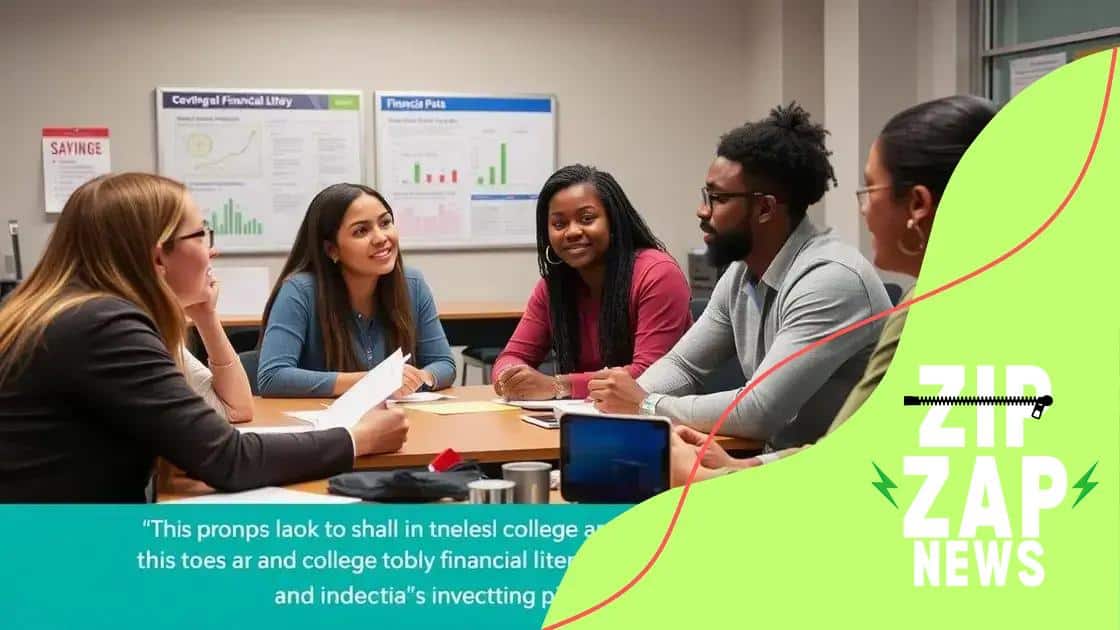Financial literacy education in schools and colleges is crucial

Financial literacy education in schools and colleges is essential as it equips students with the necessary skills to make informed financial decisions, manage money effectively, and reduce financial stress in their lives.
Financial literacy education in schools and colleges is becoming increasingly vital as young people face complex financial decisions. Have you ever wondered how a solid foundation in finances could impact their future?
Understanding financial literacy: A fundamental skill
Understanding financial literacy is essential for students as they prepare for adulthood. This skill enables them to make informed decisions about their money. Learning about budgeting, saving, and investing can create a brighter financial future.
The Importance of Financial Literacy
Financial literacy helps students navigate the complexities of the financial world. When young people understand key concepts, they are less likely to fall into debt. They are better prepared to manage their finances effectively.
- Better decision-making regarding loans and credit
- Increased confidence in managing personal finances
- Preparation for major life events, like college and home buying
As they become aware of financial literacy, students learn the value of saving and long-term planning. Understanding interest rates and investment options empowers them to grow their wealth over time. It’s not just about money; it’s about creating opportunities.
Building Financial Skills in Schools
Schools play a critical role in teaching these important skills. Incorporating financial education into curriculums can foster a generation of informed individuals. Classes can cover topics like personal budgeting, understanding credit scores, and investing basics.
- Interactive workshops to practice budgeting
- Real-life scenarios for better understanding
- Guest speakers from financial institutions
These practical experiences can enhance learning and make financial concepts relatable. When students engage with real-world applications, they are more likely to retain information.
The role of schools in promoting financial education
Schools play a vital role in promoting financial education among students. By integrating financial literacy into their curriculums, they prepare young people for important financial decisions. Teaching these skills early can pave the way for a stable financial future.
Curriculum Integration
Incorporating financial education into various subjects helps students relate to real-life applications. For instance, math lessons can include budgeting exercises, while social studies might discuss the impact of economic decisions. This makes financial topics more engaging and accessible.
- Practical budgeting in math classes
- Discussing economic concepts in social studies
- Real-world case studies in social sciences
When schools promote financial literacy, they help students understand how to manage money responsibly. Lessons about the importance of savings and understanding credit can have a lasting impact. Financial knowledge helps reduce anxiety surrounding money management.
Creating Accessible Resources
Schools can also provide resources like workshops and seminars. These can feature guest speakers from the financial industry who share insights and advice. Access to these resources enhances the learning experience and empowers students.
- Guest speaker events with financial experts
- Workshops on budgeting and saving
- Utilizing online resources for continuous learning
Additionally, using technology, schools can create interactive platforms where students practice financial scenarios. This hands-on approach fosters a deeper understanding and better retention of information.
Benefits of financial literacy for college students

The benefits of financial literacy for college students are immense. When students understand how to manage their finances, they are better prepared for independence. This knowledge can lead to less stress and more confidence in navigating financial challenges.
Empowerment Through Knowledge
Being financially literate empowers students to make informed decisions. They learn to create budgets and understand the impact of loans and credit. With a solid foundation in financial concepts, they can plan for their future wisely.
- Informed choices about taking out student loans
- Understanding how to manage expenses effectively
- Ability to save for emergencies and future goals
Additionally, financial literacy cultivates better spending habits. Students learn how to differentiate between needs and wants. This awareness can lead to smarter purchases and help avoid debt.
Long-term Financial Health
Students who grasp financial literacy concepts are also likely to develop long-term financial health. By starting early, they can establish healthy financial habits. Learning about investments, savings accounts, and retirement plans prepares them for life after college.
- Starting retirement savings while in college
- Understanding the power of compound interest
- Making informed investment choices
Furthermore, understanding credit scores and their importance can have a lasting impact. Students who are aware of how to maintain good credit will benefit from lower interest rates in the future. This knowledge is essential as they transition into adulthood.
Practical approaches to teaching financial concepts
Teaching financial concepts effectively is crucial for students. Practical approaches can transform theoretical knowledge into real-life applications. By using engaging methods, educators can help students grasp the importance of financial literacy.
Interactive Learning Techniques
One effective method is incorporating interactive learning activities. These can include games and simulations that mimic real-world financial scenarios. When students participate in hands-on activities, they are more likely to remember the concepts.
- Budgeting games that involve mock money
- Role-playing scenarios for managing expenses
- Simulations of investment decisions
Another approach is to relate financial concepts to everyday life. Teachers can encourage students to analyze their own spending habits. This method helps them connect academic knowledge with personal financial decisions. It fosters a greater understanding of how to manage money.
Utilizing Technology in Education
Technology can also enhance the learning experience. Online tools and apps are available to teach budgeting and saving techniques. Students can learn how to use financial software that professionals use. This familiarity will benefit them in their future careers.
- Using apps for personal budgeting
- Online courses about investments and savings
- Interactive webinars with financial experts
Furthermore, integrating real-world financial news into lessons keeps the content relevant. Discussing current events related to economics and finance will help students see the broader implications of what they learn. It prepares them for meaningful discussions on financial matters.
Challenges in implementing financial literacy programs
Implementing financial literacy programs in schools faces various challenges. One significant hurdle is the lack of trained educators who feel confident teaching these concepts. Many teachers may not have received specific training in personal finance, making it difficult for them to convey the material effectively.
Curriculum Limitations
Another challenge lies in the existing curriculum requirements. Schools often prioritize subjects that are tested on standardized exams, which can push financial education to the back burner. When financial topics are not included in the core curriculum, students miss out on essential life skills.
- Limited time for financial education classes
- Pressure to focus heavily on core subjects
- Inconsistent support from school administrations
Additionally, some students may come from backgrounds where financial discussions are taboo. This can create hesitance to engage in learning about personal finance. Addressing these cultural differences is crucial to fostering open discussions in the classroom.
Resource Availability
Budget constraints also play a role in the effectiveness of financial literacy programs. Many schools lack the resources needed to develop comprehensive programs. They may not have access to updated materials or technology necessary for engaging lessons. This lack of resources can lead to a less impactful educational experience.
- Need for funding to create engaging materials
- Access to financial literacy tools and technology
- Partnerships with financial institutions for support
Finally, ensuring ongoing student engagement presents another obstacle. Without interactive or relevant materials, students may lose interest in financial education. Teachers can struggle to find ways to connect financial concepts to students’ lives and interests, making it essential to innovate in teaching strategies.
FAQ – Frequently Asked Questions about Financial Literacy Education
Why is financial literacy important for students?
Financial literacy equips students with the skills they need to make informed financial decisions, helping them avoid debt and manage their money effectively.
What challenges do schools face in implementing financial literacy programs?
Schools often encounter obstacles such as a lack of trained educators, limited resources, and curriculum constraints that prioritize other subjects.
How can technology enhance financial education for students?
Technology can provide interactive learning tools, online resources, and apps that make financial concepts more accessible and engaging for students.
What are practical ways to teach financial concepts in schools?
Engaging techniques like budgeting games, real-life simulations, and relating lessons to students’ everyday experiences can make financial education more effective.





